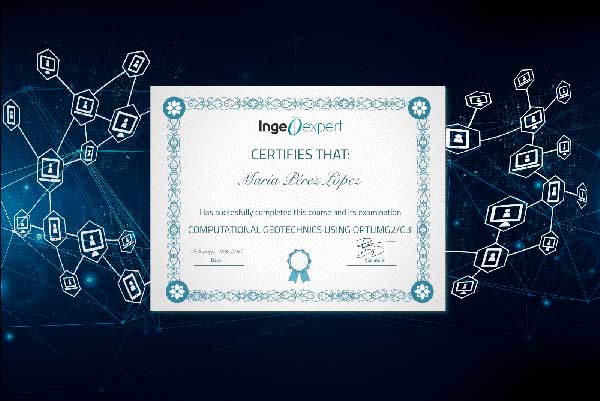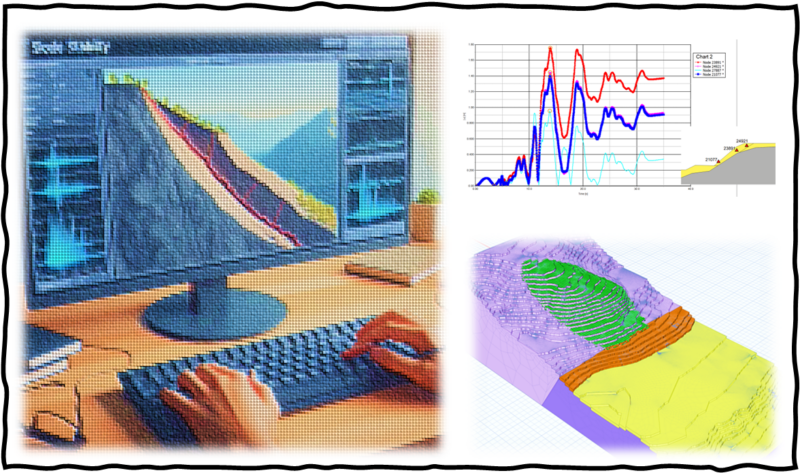Seismic Slope Stability Analysis
Online course |
|
50 hours/6 weeks |
|
|
Dates: 4th of November to 16th of December |
| Standard | Unemployed Or Student |
| $313 | $227 |
Introduction
Seismic slope stability is of utmost importance due to its direct impact on public safety and infrastructure resilience. First, slopes are prone to instability during earthquakes, which can trigger landslides. Analyzing slope stability also helps geo-professionals assess the safety of existing structures (such as roads, embankments, and dams) built on slopes. By understanding the potential for slope failure during seismic events, they can implement necessary measures to protect infrastructure. Furthermore, understanding slope behavior during earthquakes informs emergency response plans. Evacuation routes, hazard mapping, and early warning systems rely on accurate slope stability assessments. Hence, seismic slope stability analysis is crucial for safeguarding lives, minimizing property damage, and ensuring resilient infrastructure in earthquake-prone regions.
This course is specifically designed for geo-professionals seeking certified professional training in slope stability with a focus on seismic analysis. Rather than focusing solely on teaching you how to use a specific software code, this course aims to provide a deeper understanding of the subject by exploring both simplified and complex tools that can assist in solving seismic slope stability problems. Throughout the course, you’ll delve into concepts such as pseudo-static analysis, seismic displacements, acceleration time-history, limit equilibrium (LE) and more advanced finite element (FE) modeling, all within the context of seismic analyses. By the end of the course, you’ll have gained a better understanding of the seismic modelling of slopes.
Objectives
- To understand the basic theories of pseudo-static analysis, the concept of coefficient of horizontal acceleration (kh) and yield acceleration (ky)
- To understand the earthquake-induced (seismic) slope displacements
- To learn how to carry out an estimation of seismic displacements using Newmark block model.
- To learn how to implement GeoSlope for 2D and 3D seismic slope stability limit equilibrium (LE) analyses.
- To learn how to implement Plaxis2D to perform a pseudo-static finite element (FE) analysis.
- To learn how to obtain, select, and modify the acceleration time-history records for using in a non-linear time-history (NLTH) analysis.
- To learn how to implement Plaxis2D to perform a dynamic NLTH FE analysis.
- Fundamentals of pseudo-static analysis
- – Inertia force
- – Pseudo-static analysis
- – Coefficient of horizontal acceleration (kh)
- – Yield or Critical acceleration (ky, kc)
- Seismic displacements
- – Earthquake time-history records
- – Newmark sliding block model (Rigid-Plastic)
- – Modified Newmark sliding block model (Rigid-Elastic)
- – Displacement / yield acceleration relationship
- – SLAMMER – Seismic Landslide Movement Modeled using Earthquake Records
- Limit Equilibrium Analysis using SLOPE/W
- – Method basics
- – Selecting an appropriate method
- – Slip surface shapes.
- – Stress distributions.
- – Total vs effective stress approaches
- – Material Strength
- – Seepage forces
- – Pore-water pressure (PWP)
- – Reinforcement and structural components
- – Probabilistic and sensitivity analyses
- – Seismic slope stability examples
- SLOPE3D modelling
- – Methods for generating 3D geometry items
- – The Boolean operations used to cut or imprint geometry items
- – Assign materials and boundary conditions
- – Options for constraining and generating the 3D mesh
- – Methods for viewing and exporting 3D results
- – Seismic slope stability examples
- Pseudo-static Finite Element (FE) analysis using Plaxis 2D
- – Finite Element modeling using Plaxis 2D
- – Material models, meshing, and boundary condition in pseudo-static analyses
- – Factor of Safety analysis and the concept of strength reduction method
- – Interpretation outputs & results
- Non-linear time-history (NLTH) Finite Element (FE) analysis using Plaxis 2D
- – Selection and modification of the acceleration time-history records
- – Material modeling considerations in dynamic calculations
- – Rayleigh vs hysteresis damping
- – Modification of input ground motion records
- – Boundary conditions in dynamic calculation
- – Mesh and time step considerations in dynamic calculation.
- – Interpretation outputs & results
- – Comparison of dynamic and pseudo-static analyses
Amir Alipour
Amir is a highly skilled and motivated engineer with a solid background in soil mechanics, and over 15 years of involvement in a variety of engineering projects. He received his BSc degree in Civil Engineering in 2006, and MSc degree in Geotechnical Engineering in 2011, respectively. He has implemented his technical skills to provide geotechnical designs to a wide range of sectors including land development for residential, commercial, and industrial projects, mining, road, bridge, dam, petrochemical complex, power plant, and renewable energy projects.
His engineering skill is defined by a commitment to avoiding unnecessary conservatism in designs as well as utilizing different tools to enhance the understanding of geotechnical behaviour of structures. This involves employing field observation and back analysis to reduce the uncertainties. He also incorporates 3D modelling in cases where traditional 2D methods fall short in accurately representing the actual behaviour of the structures. His approach includes optimizing designs through sensitivity studies and considering the construction budget and time in comparative analyses.
He has proven expertise in project scoping and planning of the site investigations in different geological conditions, with a focus on earth-retaining wall, rock-fall protection, dam, tunnel, foundation, and landslide. Additionally experienced in deep urban excavations, piling and micro-piling, ground improvement, underpinning, instrumentation, and performance monitoring.
He is also adept at implementing software for problem-solving: GEO5, PLAXIS 2D & 3D, LPILE, SLIDE3, SLIDE2, RS2, MACRO Studio [Maccaferri Software Suite], CSI SAFE, CSI SAP2000, Surfer, GeoStudio (2D & 3D), AutoCAD, CloudCompare, CPet-IT, CLiq, SPAS 2019, LiqSVs [GeoLogismiki Software Suite], LiquefyPro, Wallap, SeismoSignal, SesimoSelect, SeismoMatch, Deepsoil, SLAMMER, ELPLA, Python Programming.
The course is delivered online through our easy-to-use Virtual Campus platform. For this course, a variety of content is provided including:
– eLearning materials
– Videos
– Interactive multimedia content
– Live webinar classes
– Texts and technical articles
– Case studies
– Assignments and evaluation exercises
Students can download the materials and work through the course at their own pace.
We regularly update this course to ensure the latest news and state-of-the-art developments are covered, and your knowledge of the subject is current.
Live webinars form part of our course delivery. These allow students and tutors to go through the course materials, exchange ideas and knowledge, and solve problems together in a virtual classroom setting. Students can also make use of the platform’s forum, a meeting point to interact with tutors and other students.
The tutoring system is managed by email. Students can email the tutor with any questions about the course and the tutor will be happy to help.
This course is designed for engineers and geologists at all levels, including those working in consulting engineering firms, engineering contractors, universities, research and development companies, and students in their final academic year studying civil/mining engineering or engineering geology. Participants will gain a solid understanding of the fundamental principles of engineering geology.
Prerequisites:
- – Basic knowledge/background in Slope Stability, Limit Equilibrium (LE) analysis, Finite Element (FE) modeling, and seismology.
- -While experience with FE and LE based software such as SLOPE/W and Plaxis is desirable, it is not a strict pre-requisite for enrollment.
Once a student finishes the course and successfully completes the assignments and evaluation tests, they are sent an accreditation certificate. The certificate is issued by Ingeoexpert to verify that the student has passed the course. It is a digital certificate that is unique and tamper-proof – it is protected by Blockchain technology. This means it is possible for anyone to check that it is an authentic, original document.
Introduction
Seismic slope stability is of utmost importance due to its direct impact on public safety and infrastructure resilience. First, slopes are prone to instability during earthquakes, which can trigger landslides. Analyzing slope stability also helps geo-professionals assess the safety of existing structures (such as roads, embankments, and dams) built on slopes. By understanding the potential for slope failure during seismic events, they can implement necessary measures to protect infrastructure. Furthermore, understanding slope behavior during earthquakes informs emergency response plans. Evacuation routes, hazard mapping, and early warning systems rely on accurate slope stability assessments. Hence, seismic slope stability analysis is crucial for safeguarding lives, minimizing property damage, and ensuring resilient infrastructure in earthquake-prone regions.
This course is specifically designed for geo-professionals seeking certified professional training in slope stability with a focus on seismic analysis. Rather than focusing solely on teaching you how to use a specific software code, this course aims to provide a deeper understanding of the subject by exploring both simplified and complex tools that can assist in solving seismic slope stability problems. Throughout the course, you’ll delve into concepts such as pseudo-static analysis, seismic displacements, acceleration time-history, limit equilibrium (LE) and more advanced finite element (FE) modeling, all within the context of seismic analyses. By the end of the course, you’ll have gained a better understanding of the seismic modelling of slopes.
Objectives
- To understand the basic theories of pseudo-static analysis, the concept of coefficient of horizontal acceleration (kh) and yield acceleration (ky)
- To understand the earthquake-induced (seismic) slope displacements
- To learn how to carry out an estimation of seismic displacements using Newmark block model.
- To learn how to implement GeoSlope for 2D and 3D seismic slope stability limit equilibrium (LE) analyses.
- To learn how to implement Plaxis2D to perform a pseudo-static finite element (FE) analysis.
- To learn how to obtain, select, and modify the acceleration time-history records for using in a non-linear time-history (NLTH) analysis.
- To learn how to implement Plaxis2D to perform a dynamic NLTH FE analysis.
- Fundamentals of pseudo-static analysis
- – Inertia force
- – Pseudo-static analysis
- – Coefficient of horizontal acceleration (kh)
- – Yield or Critical acceleration (ky, kc)
- Seismic displacements
- – Earthquake time-history records
- – Newmark sliding block model (Rigid-Plastic)
- – Modified Newmark sliding block model (Rigid-Elastic)
- – Displacement / yield acceleration relationship
- – SLAMMER – Seismic Landslide Movement Modeled using Earthquake Records
- Limit Equilibrium Analysis using SLOPE/W
- – Method basics
- – Selecting an appropriate method
- – Slip surface shapes.
- – Stress distributions.
- – Total vs effective stress approaches
- – Material Strength
- – Seepage forces
- – Pore-water pressure (PWP)
- – Reinforcement and structural components
- – Probabilistic and sensitivity analyses
- – Seismic slope stability examples
- SLOPE3D modelling
- – Methods for generating 3D geometry items
- – The Boolean operations used to cut or imprint geometry items
- – Assign materials and boundary conditions
- – Options for constraining and generating the 3D mesh
- – Methods for viewing and exporting 3D results
- – Seismic slope stability examples
- Pseudo-static Finite Element (FE) analysis using Plaxis 2D
- – Finite Element modeling using Plaxis 2D
- – Material models, meshing, and boundary condition in pseudo-static analyses
- – Factor of Safety analysis and the concept of strength reduction method
- – Interpretation outputs & results
- Non-linear time-history (NLTH) Finite Element (FE) analysis using Plaxis 2D
- – Selection and modification of the acceleration time-history records
- – Material modeling considerations in dynamic calculations
- – Rayleigh vs hysteresis damping
- – Modification of input ground motion records
- – Boundary conditions in dynamic calculation
- – Mesh and time step considerations in dynamic calculation.
- – Interpretation outputs & results
- – Comparison of dynamic and pseudo-static analyses
Amir Alipour
Amir is a highly skilled and motivated engineer with a solid background in soil mechanics, and over 15 years of involvement in a variety of engineering projects. He received his BSc degree in Civil Engineering in 2006, and MSc degree in Geotechnical Engineering in 2011, respectively. He has implemented his technical skills to provide geotechnical designs to a wide range of sectors including land development for residential, commercial, and industrial projects, mining, road, bridge, dam, petrochemical complex, power plant, and renewable energy projects.
His engineering skill is defined by a commitment to avoiding unnecessary conservatism in designs as well as utilizing different tools to enhance the understanding of geotechnical behaviour of structures. This involves employing field observation and back analysis to reduce the uncertainties. He also incorporates 3D modelling in cases where traditional 2D methods fall short in accurately representing the actual behaviour of the structures. His approach includes optimizing designs through sensitivity studies and considering the construction budget and time in comparative analyses.
He has proven expertise in project scoping and planning of the site investigations in different geological conditions, with a focus on earth-retaining wall, rock-fall protection, dam, tunnel, foundation, and landslide. Additionally experienced in deep urban excavations, piling and micro-piling, ground improvement, underpinning, instrumentation, and performance monitoring.
He is also adept at implementing software for problem-solving: GEO5, PLAXIS 2D & 3D, LPILE, SLIDE3, SLIDE2, RS2, MACRO Studio [Maccaferri Software Suite], CSI SAFE, CSI SAP2000, Surfer, GeoStudio (2D & 3D), AutoCAD, CloudCompare, CPet-IT, CLiq, SPAS 2019, LiqSVs [GeoLogismiki Software Suite], LiquefyPro, Wallap, SeismoSignal, SesimoSelect, SeismoMatch, Deepsoil, SLAMMER, ELPLA, Python Programming.
The course is delivered online through our easy-to-use Virtual Campus platform. For this course, a variety of content is provided including:
– eLearning materials
– Videos
– Interactive multimedia content
– Live webinar classes
– Texts and technical articles
– Case studies
– Assignments and evaluation exercises
Students can download the materials and work through the course at their own pace.
We regularly update this course to ensure the latest news and state-of-the-art developments are covered, and your knowledge of the subject is current.
Live webinars form part of our course delivery. These allow students and tutors to go through the course materials, exchange ideas and knowledge, and solve problems together in a virtual classroom setting. Students can also make use of the platform’s forum, a meeting point to interact with tutors and other students.
The tutoring system is managed by email. Students can email the tutor with any questions about the course and the tutor will be happy to help.
This course is designed for engineers and geologists at all levels, including those working in consulting engineering firms, engineering contractors, universities, research and development companies, and students in their final academic year studying civil/mining engineering or engineering geology. Participants will gain a solid understanding of the fundamental principles of engineering geology.
Prerequisites:
- – Basic knowledge/background in Slope Stability, Limit Equilibrium (LE) analysis, Finite Element (FE) modeling, and seismology.
- -While experience with FE and LE based software such as SLOPE/W and Plaxis is desirable, it is not a strict pre-requisite for enrollment.
Once a student finishes the course and successfully completes the assignments and evaluation tests, they are sent an accreditation certificate. The certificate is issued by Ingeoexpert to verify that the student has passed the course. It is a digital certificate that is unique and tamper-proof – it is protected by Blockchain technology. This means it is possible for anyone to check that it is an authentic, original document.
More info
Finish this course and get a certificate based on Blockchain
Seismic Slope Stability Analysis

Blockchain technology makes the certificate incorruptible, enabling companies to verifiy its autenticity.
Seismic Slope Stability Analysis
| $313 | $227 | |
| Get more information |




Reviews
There are no reviews yet.